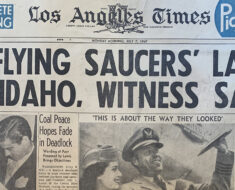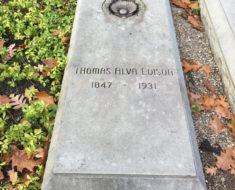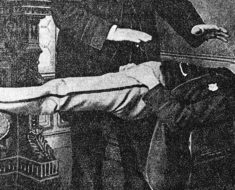If life exists on Mars, we might make contact with it using a whole lot of mirrors flashing lights into the sky.
That’s what Harvard Professor W.H. Pickering considered in 1909. However, his plan to communicate with the red planet would cost $10 million. A steep price, particularly at the start of the 20th century.
Though Pickering wasn’t a big believer in Martians, as other scientists at the time were (based particularly on the observation of what were believed to be canals), he felt this method help find out for sure.

Mirror signal for Mars, from Popular Mechanics 1909.
“My scheme,” Pickering told Popular Mechanics, “is to fix 50 mirrors, each mirror 25 ft. square, on shafts like the polar axis of an equatorial telescope. Each large mirror should be made up of 100 little ones, 2 ½ ft. square. There should be 50 shafts, thus bringing the total number of 25-ft. square mirrors up to 2,500. …
“The shafts would be mounted parallel to the axis of the earth, and caused to revolve by means of motors in a direction opposite to that in which the world revolves. By this means a steady flash of light, bright enough to be visible through a telescope, would be sent from the earth to Mars. …”
He believed the signals should continue for three to four months, and be repeated for several years. This, he felt, should be sufficient time for any intelligent life to notice the signals and construct a similar means of returning a message.
“In hoping to get such signals back, we must assume, of course, that the Martians, if there are any, have telescopes, eyes, etc., just as human beings have on this earth.”
While the professor seemed to have thoroughly thought through his plan, there was still the matter of obtaining the necessary funds to proceed.
![Andrew Carnegie, potential benefactor for Pickering's Mars mirrors. Theodore C. Marceau [Public domain], via Wikimedia Commons.](https://www.weirdhistorian.com/wp-content/uploads/2018/01/Andrew_Carnegie_1913-Theodore-C.-Marceau-Public-domain-via-Wikimedia-Commons.jpg)
Andrew Carnegie, potential benefactor for Pickering’s Mars mirrors. Theodore C. Marceau [Public domain], via Wikimedia Commons.
Pickering had, in fact, gone to Carnegie seven years earlier to make a pitch for a Carnegie Astronomical Fund in connection with Harvard Observatory. The wealthy industrialist said no.
“At this point Professor Pickering would find it necessary to persuade the great capitalist who is striving to die poor that the £2,000,000 would not be flashed off into space and never be heard from again,” the paper wrote. “In short, the professor must demonstrate a reasonable probability that the Martians are on the watch waiting for us to open up communication with their own planet, and would understand the earth’s signals.”
French astronomer Camille Flammarion fueled much of their enthusiasm. He believed Martian life might be a million years ahead of us humans. This created hope and anticipation for what their advanced intelligence might offer earth.
“Success in signaling would mean more than anything that has happened since the earth shot off from the sun,” the Post claimed.
For, assuming that there are Martians a million years in advance of us, let us consider for a moment the solid information they could give us concerning the problem of the earth. … It would be enormously helpful to hear how Mars settled his race questions and composed the quarrels of capital and labour… One can think of a thousand questions to flash up to the Martians—how they perfected flying machines, how they cured cancer, what finally became of war, whether they have any use for lawyers … If Mr. Carnegie has any imagination, how can he cast aside such a stupendous opportunity?”
All questions we’d still love higher intelligence to help us answer.






